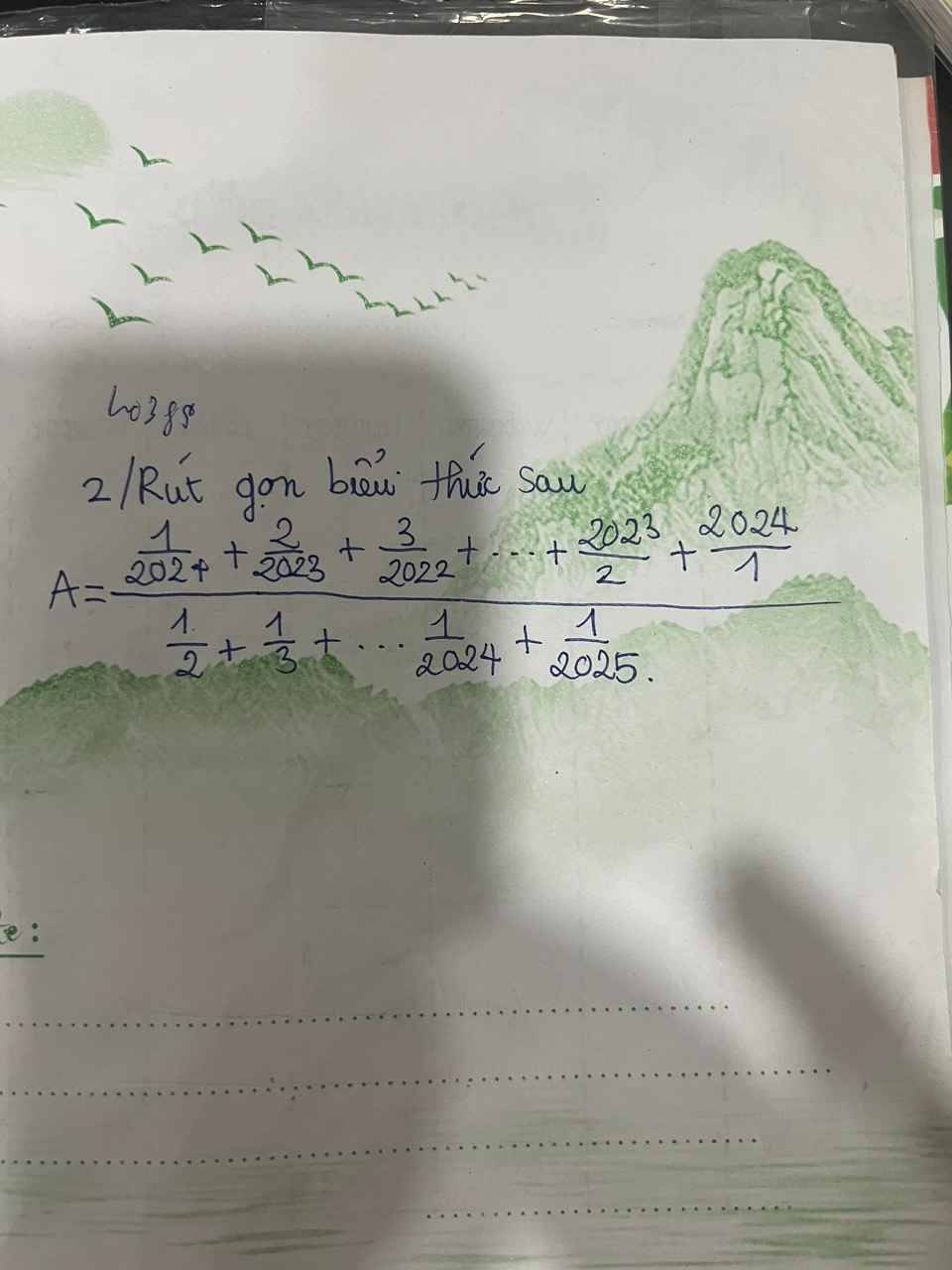
Hãy nhập câu hỏi của bạn vào đây, nếu là tài khoản VIP, bạn sẽ được ưu tiên trả lời.


\(\dfrac{2}{3}:\left(x-\dfrac{1}{3}\right)^3-9=\dfrac{23}{3}\)
=>\(\dfrac{2}{3}:\left(x-\dfrac{1}{3}\right)^3=\dfrac{23}{3}+9=\dfrac{50}{3}\)
=>\(\left(x-\dfrac{1}{3}\right)^3=\dfrac{2}{3}:\dfrac{50}{3}=\dfrac{1}{25}\)
=>\(x-\dfrac{1}{3}=\dfrac{\sqrt[3]{5}}{5}\)
=>\(x=\dfrac{\sqrt[3]{5}}{5}+\dfrac{1}{3}=\dfrac{3\sqrt[3]{5}+5}{15}\)

x² - 2x = 8
x² - 2x - 8 = 0
x² - 2x + 1 - 9 = 0
(x² - 2x + 1) - 9 = 0
(x - 1)² - 3² = 0
(x - 1 - 3)(x - 1 + 3) = 0
(x - 4)(x + 2) = 0
⇒ x - 4 = 0 hoặc x + 2 = 0
*) x - 4 = 0
x = 4
*) x + 2 = 0
x = -2
Vậy x = -2; x = 4

Nếu giảm giá \(\dfrac{2}{5}\) thì giảm số tiền là:
27500\(\cdot\dfrac{2}{5}=11000\) (đồng)
Nếu giảm giá \(\dfrac{2}{5}\) thì giá bán mới của quyển sách đó là:
27500-11000=16500 (đồng)
Vậy nếu giảm giá \(\dfrac{2}{5}\) thì giá bán mới của quyển sách là 16500 đồng.
Lời giải:
Nếu giảm giá 2/5 thì giá bán mới bằng $1-\frac{2}{5}=\frac{3}{5}$ giá cũ.
Giá bán mới của quyển sách là:
$27500\times \frac{3}{5}=16500$ (đồng)

Ta có P = 1/9 + 2/8 + 3/7 + ...+ 8/2 + 9/1
P +9 = 1+ 1/9 + 1 +2 / 8 + ... + 1+8/2 + 1+9
P = 10/9 + 10/8 + .....+ 10/2 + 10/1 -9
P = 10/9 + 10/8 + .....+ 10/2 + 10/10
P = 10 . ( 1/2 + 1/3 + ... + 1/9 + 1/10)
Vật x = 10

a: Số cây trồng bằng 5/4 số cây chưa trồng
=>Số cây chưa trồng chiếm \(\dfrac{4}{5+4}=\dfrac{4}{9}\) tổng số cây
=>210 cây ngày thứ hai trồng chiếm:
\(1-\dfrac{2}{5}-\dfrac{4}{9}=\dfrac{3}{5}-\dfrac{4}{9}=\dfrac{7}{45}\)(tổng số cây)
Tổng số cây phải trồng là \(210:\dfrac{7}{45}=210\cdot\dfrac{45}{7}=30\cdot45=1350\left(cây\right)\)
b: Số cây chưa trồng là \(1350\cdot\dfrac{4}{9}=600\left(cây\right)\)

\(A=\dfrac{4,29\times1230-429\times2,3}{30-15+36-18+42-21+...+96-48+102-51}\)
\(A=\dfrac{429\times1230:100-429\times2,3}{15+18+21+...+48+51}\)
\(A=\dfrac{429\times12,3-429\times2,3}{\left(51+15\right)\times13:2}\)
\(A=\dfrac{429\times\left(12,3-2,3\right)}{429}\)
\(A=\dfrac{429\times10}{429}\)
\(A=10\)

Số học sinh đạt điểm giỏi của lớp đó là:
\(27\times\dfrac{1}{9}=3\) (học sinh).
Số học sinh đạt điểm khá của lớp đó là:
\(3\times\dfrac{7}{3}=7\) (học sinh).
Số học sinh đạt điểm trung bình của lớp đó là:
\(7\times\dfrac{3}{7}=3\) (học sinh).
Số học sinh đạt điểm yếu của lớp đó là:
\(27-\left(3+7+3\right)=14\) (học sinh.)
Đáp số: Số học sinh giỏi: `3` học sinh.
Số học sinh khá: `7` học sinh.
Số học sinh trung bình: `3` học sinh.
Số học sinh yếu: `14` học sinh.

\(\dfrac{2-x}{16}=-\dfrac{4}{x-2}\left(x\ne2\right)\\ \Rightarrow\dfrac{x-2}{16}=\dfrac{4}{x-2}\\ \Rightarrow\left(x-2\right)^2=16.4=64\\ \Rightarrow\left[{}\begin{matrix}x-2=8\\x-2=-8\end{matrix}\right.\\ \Rightarrow\left[{}\begin{matrix}x=10\\x=-6\end{matrix}\right.\left(TMDK\right)\)
Vậy x thuộc {10; -6}
\(\dfrac{2-x}{16}=\dfrac{\left(-4\right)}{x-2}\)
\(\Rightarrow\dfrac{x-2}{16}=\dfrac{4}{x-2}\)
\(\Rightarrow\left(x-2\right)\cdot\left(x-2\right)=16\cdot4\)
\(\Rightarrow\left(x-2\right)^2=64\)
\(\Rightarrow\left(x-2\right)^2=8^2\)
\(\Rightarrow\left[{}\begin{matrix}x-2=8\\x-2=-8\end{matrix}\right.\)
\(\Rightarrow\left[{}\begin{matrix}x=8+2\\x=-8+2\end{matrix}\right.\)
\(\Rightarrow\left[{}\begin{matrix}x=10\\x=-6\end{matrix}\right.\)
\(\Rightarrow\) Vậy \(x\in\left\{10;-6\right\}\)

\(\dfrac{3}{10}:\dfrac{\left(-2\right)}{3}=\dfrac{3}{10}\cdot\dfrac{\left(-3\right)}{2}=\dfrac{\left(-9\right)}{20}\)
`------`
\(\left(-\dfrac{7}{12}\right):\left(-\dfrac{5}{6}\right)\)
\(=\dfrac{\left(-7\right)}{12}\cdot\dfrac{\left(-6\right)}{5}\)
\(=\dfrac{42}{60}=\dfrac{7}{10}\)
`------`
\(\left(-15\right):\dfrac{\left(-9\right)}{10}\)
\(=\left(-15\right)\cdot\dfrac{\left(-10\right)}{9}\)
\(=\dfrac{150}{9}=\dfrac{50}{3}\)
\(A=\dfrac{\dfrac{1}{2024}+\dfrac{2}{2023}+...+\dfrac{2023}{2}+\dfrac{2024}{1}}{\dfrac{1}{2}+\dfrac{1}{3}+...+\dfrac{1}{2024}+\dfrac{1}{2025}}\)
\(=\dfrac{\left(\dfrac{1}{2024}+1\right)+\left(\dfrac{2}{2023}+1\right)+...+\left(\dfrac{2023}{2}+1\right)+1}{\dfrac{1}{2}+\dfrac{1}{3}+...+\dfrac{1}{2024}+\dfrac{1}{2025}}\)
\(=\dfrac{\dfrac{2025}{2024}+\dfrac{2025}{2023}+...+\dfrac{2025}{2}+\dfrac{2025}{2025}}{\dfrac{1}{2}+\dfrac{1}{3}+...+\dfrac{1}{2024}+\dfrac{1}{2025}}\)
\(=\dfrac{2025\left(\dfrac{1}{2}+\dfrac{1}{3}+...+\dfrac{1}{2024}+\dfrac{1}{2025}\right)}{\dfrac{1}{2}+\dfrac{1}{3}+...+\dfrac{1}{2024}+\dfrac{1}{2025}}=2025\)